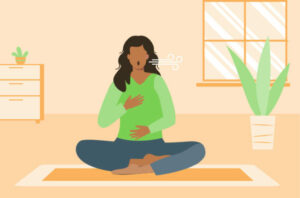“Are you tired of feeling overwhelmed by sudden and intense panic attacks? Do you want to know how to manage your symptoms effectively without relying on medication alone? Look no further, because we’ve got the first-line treatment for panic disorder that you need! In this blog post, we’ll explore the most effective ways to tackle panic disorder head-on and start living a more fulfilling life.”
Contents
Overview of Panic Disorder

Panic disorder is a condition that causes repeated episodes of panic attacks. These are periods of intense fear or discomfort that come on suddenly and typically last for several minutes. During a panic attack, you may have physical symptoms such as a pounding heart, shortness of breath, or dizziness. You may also feel like you are going to faint or lose control.
The exact cause of panic disorder is not known, but it may be related to genetics, personality traits, or an imbalance of certain chemicals in the brain. Stressful life events such as a death in the family or a traumatic experience can also trigger symptoms.
The impacts of panic disorder can be hugely disruptive to daily life, which is why it’s important to seek treatment. Sometimes medication or therapy may be necessary, but there are also several lifestyle changes and techniques that can help reduce symptoms and make living with panic disorder much easier.
First Line Treatment for Panic Disorder
Treating panic disorder as early as possible is key to minimizing its impact on your life. There are several lifestyle changes and techniques that are effective in managing the symptoms of panic disorder:
Deep Breathing Exercises

One of the first things you should try when a panic attack begins to set in is deep breathing exercises. Taking slow, deep breaths can help reduce the intensity of the symptoms and make it easier to relax your body and mind.
These deep breathing exercises should involve taking slow, deep breaths while focusing on the sensation of air entering and leaving your body. While doing this exercise, try to keep your shoulders relaxed and count each breath until you feel yourself calming down.
Mindfulness Meditation
Mindfulness meditation can be a great way to manage symptoms of panic disorder. This type of meditation is the practice of focusing on the present moment, without judgment or analysis. This can help reduce fear and anxiety and make it easier to manage panic attacks.
Mindfulness meditation involves sitting in a quiet place for at least five minutes and focusing on your breathing. As thoughts come up, let them go and return your focus to your breath. This exercise can help reduce stress and anxiety, as well as increase your self-awareness.
Physical Activity
Regular exercise has been shown to have a positive effect on mental health and can be beneficial for those with panic disorder. Physical activity releases endorphins, hormones that make you feel good and reduce stress and anxiety. Aim for at least 30 minutes of moderate exercise each day.
Certain types of physical activities can be particularly helpful for those with panic disorder. Yoga, tai chi, and qi gong have all been found to reduce symptoms of anxiety and panic attacks.
Good Sleep

Another important factor in managing panic disorder is getting enough restful sleep. Poor quality of sleep can increase the risk of a panic attack, so it’s essential to make sure you get at least seven hours of sleep each night.
If you are having difficulty sleeping, some strategies can help. For example, avoiding caffeine before bed, establishing a regular sleep schedule, and avoiding screens before bedtime can all help improve the quality of your rest.
Medications
One of the most common options for treating panic disorder is medication. Selective serotonin reuptake inhibitors (SSRIs) are the most commonly prescribed type of medication for this condition. These medications work by affecting neurotransmitters in the brain, which can help reduce symptoms of anxiety and panic attacks.
However, it’s important to discuss any medication with your doctor before taking it. Medication can be effective in treating panic disorder, but it is not a long-term solution and should be used only under the guidance of a medical professional.
Therapy
In addition to lifestyle changes and medications, therapy can be an important part of treatment for panic disorder. Talking to a therapist can help you explore the underlying causes of your anxiety and develop coping strategies to manage symptoms. Cognitive behavioral therapy (CBT) is a type of talk therapy that is particularly effective in treating panic disorder.
Another type of therapy is exposure therapy, which involves gradually exposing yourself to the situations and things that cause your panic attacks. This can help you learn to control and manage your symptoms so that they don’t overwhelm you in the future.
Is First-Line Treatment for Panic Disorder Effective?

The effectiveness of first-line treatment for panic disorder is widely debated. Proponents of the treatment argue that it can be successful in reducing anxiety levels, while opponents state that the treatment may not always provide long-term relief or improve the overall quality of life.
According to some reports, the effectiveness also depends on the type of treatment used, as well as the individual’s history with anxiety and panic attacks Some reports suggest that cognitive-behavioral therapy (CBT) is the most effective treatment for people with panic disorder. CBT helps individuals understand, manage and cope with their thoughts and behaviors related to anxiety by providing them with skills and techniques to alter how they think about certain situations.
In addition, research has found that medication such as selective serotonin reuptake inhibitors (SSRIs) can be effective in treating the symptoms of panic disorder. SSRIs work by increasing the availability of serotonin, a neurotransmitter that helps regulate mood, in the brain.
Pros and Cons of First-Line Treatment for Panic Disorder

Some of the benefits of first-line treatments for panic disorder include:
- Reduced frequency and intensity of panic attacks
- Improved quality of life
- Increased ability to cope with everyday stressors
- More control over your environment and reactions to it.
However, there are also potential drawbacks associated with the use of first-line treatment for panic disorder. These include:
- Potential side effects from medication, such as drowsiness or nausea
- Limited effectiveness for some people with more severe symptoms
- The need to maintain a regular schedule of treatment and follow-up visits with your doctor
- Difficulty finding the right combination of medications and therapies that work best for you
- The possible financial burden of treatment costs.
It is important to consider the pros and cons when considering first-line treatments for panic disorder. Your doctor can help you decide which option is best for you.
Conclusion
In conclusion, panic disorder is a serious condition that should be taken seriously. The first line of treatment for panic disorder includes lifestyle changes, psychotherapy, and medications such as selective serotonin reuptake inhibitors and benzodiazepines. It’s important to find the right combination of treatments for you so that you can manage your symptoms effectively. With the right approach, you can learn to live with anxiety without letting it control your life.
For more information, please contact MantraCare. Anxiety is a feeling of fear, worry, and unease often related to an upcoming event or uncertain outcome. If you have any queries regarding Online Anxiety Counseling experienced therapists at MantraCare can help: Book a trial Anxiety therapy session


